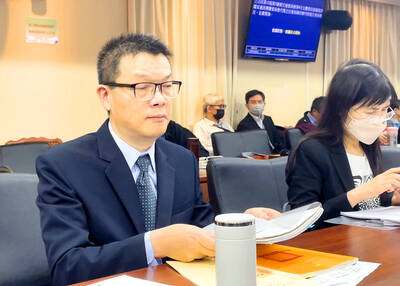The administration of President Ma Ying-jeou (馬英九) must phase out the nation’s three operational nuclear power plants and stop the fourth from coming online or let the public decide the matter through referendum, experts told a forum on nuclear security yesterday.
“A decision should be made within a year so we can minimize the overall potential danger,” said Chan Chang-chuan (詹長權), a professor at National Taiwan University’s Institute of Occupational Medicine and Industrial Hygiene.
While nobody wants to see a repeat of Japan’s nuclear crisis, Chan said “several signs” pointed to the likelihood that Taiwan’s three nuclear power plants would face a crisis under similar circumstances.
While Ma said earlier this week he hoped Taipei and Beijing would cooperate on nuclear safety, Chan said nuclear security was a global matter requiring international cooperation.
“My suggestion is that Taiwan talk with the international community rather than turn to China to solve all its problems,” Chan told the forum, which was organized by the Taiwan Brain Trust (TBT).
TBT chairman Wu Rong-i (吳榮義) said the Ma administration was reluctant to stop construction at the Fourth Nuclear Power Plant in Gongliao District (貢寮), New Taipei City (新北市), because it concerned massive business interests.
“The contract has been signed so the government still has to pay up if it stops work at the plant,” he said. “Unless Taiwanese speak up and tell the government what they want, the government will push its own agenda.”
Shih Shin-min (施信民), a professor of chemical engineering at National Taiwan University, said Taiwan had a chance to become a nuclear-free country.
“It is all about political will,” he said.
“While nuclear power accounts for 10.72 percent of the [nation’s] total power supply, there would still be a 28.1 percent surplus of electricity left during peak hours if we shut down three of the nuclear power plants and stop building the fourth,” he said. “At the moment, we don’t need to rely on nuclear power.”
Shih also cast doubt on assurances by the Atomic Energy Council and Taiwan Power Co, which operates the plants, that Taiwan’s nuclear power plants were safe.
Wang To-far (王塗發), a professor of economics at National Taipei University, said Taiwan had significant potential to develop renewable energy.
Taiwan can generate 5,000MW of wind power, much more than the 2,700MW the Fourth Nuclear Power Plant would produce once it comes online, he said, adding that Taiwan would have no problem producing 1GW with solar energy.
“It is possible to increase the power generated by renewable energy from 6 percent to 12 percent by 2020,” he said. “However, the problem is whether the Ma administration has the political will and determination to do so.”
Wang said the Ma administration was not enthusiastic about clean energy because it was bent on promoting nuclear power. As the Fourth Nuclear Power Plant is near completion, the government has reached the conclusion that it is unnecessary to develop renewable energy, he said.
However, the Fourth Nuclear Power Plant has many problems, including the use of sub-standard materials and the “illegal” alteration of 700 safety-related designs, which is being investigated by the Control Yuan, Wang said.

‘DENIAL DEFENSE’: The US would increase its military presence with uncrewed ships, and submarines, while boosting defense in the Indo-Pacific, a Pete Hegseth memo said The US is reorienting its military strategy to focus primarily on deterring a potential Chinese invasion of Taiwan, a memo signed by US Secretary of Defense Pete Hegseth showed. The memo also called on Taiwan to increase its defense spending. The document, known as the “Interim National Defense Strategic Guidance,” was distributed this month and detailed the national defense plans of US President Donald Trump’s administration, an article in the Washington Post said on Saturday. It outlines how the US can prepare for a potential war with China and defend itself from threats in the “near abroad,” including Greenland and the Panama

A wild live dugong was found in Taiwan for the first time in 88 years, after it was accidentally caught by a fisher’s net on Tuesday in Yilan County’s Fenniaolin (粉鳥林). This is the first sighting of the species in Taiwan since 1937, having already been considered “extinct” in the country and considered as “vulnerable” by the International Union for Conservation of Nature. A fisher surnamed Chen (陳) went to Fenniaolin to collect the fish in his netting, but instead caught a 3m long, 500kg dugong. The fisher released the animal back into the wild, not realizing it was an endangered species at

The High Prosecutors’ Office yesterday withdrew an appeal against the acquittal of a former bank manager 22 years after his death, marking Taiwan’s first instance of prosecutors rendering posthumous justice to a wrongfully convicted defendant. Chu Ching-en (諸慶恩) — formerly a manager at the Taipei branch of BNP Paribas — was in 1999 accused by Weng Mao-chung (翁茂鍾), then-president of Chia Her Industrial Co, of forging a request for a fixed deposit of US$10 million by I-Hwa Industrial Co, a subsidiary of Chia Her, which was used as collateral. Chu was ruled not guilty in the first trial, but was found guilty

DEADLOCK: As the commission is unable to forum a quorum to review license renewal applications, the channel operators are not at fault and can air past their license date The National Communications Commission (NCC) yesterday said that the Public Television Service (PTS) and 36 other television and radio broadcasters could continue airing, despite the commission’s inability to meet a quorum to review their license renewal applications. The licenses of PTS and the other channels are set to expire between this month and June. The National Communications Commission Organization Act (國家通訊傳播委員會組織法) stipulates that the commission must meet the mandated quorum of four to hold a valid meeting. The seven-member commission currently has only three commissioners. “We have informed the channel operators of the progress we have made in reviewing their license renewal applications, and